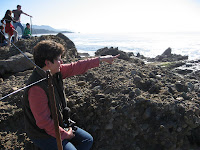Much has happened since the last entry in this blog, we are now
 in the Tucson area. Actually we are in Pima county between Tucson and Marana, We used to live on 3.5 acres in the Santa Cruz mountains, now we live on 3.3 acres in the Tucson mountains. We used to hike through Redwoods, now we hike through Saguaros. Redwoods and Saguaros are different and yet very much the same in their uniqueness. Old living plants that are both far from the ordinary.
in the Tucson area. Actually we are in Pima county between Tucson and Marana, We used to live on 3.5 acres in the Santa Cruz mountains, now we live on 3.3 acres in the Tucson mountains. We used to hike through Redwoods, now we hike through Saguaros. Redwoods and Saguaros are different and yet very much the same in their uniqueness. Old living plants that are both far from the ordinary.The day was cool/ cold. It was 25 degrees overnight ( yes the desert does get cold). It was mid 30's when we started but warmed to high 40's along the way. The snow level in the surrounding mountains was about 4000 feet. We set out to walk the Sweetwater trail which ultimately takes one to the top of Mt Wasson. Mt Wasson is the highest peak in the Tucson mountain range and affords a spectacular view of
 Tucson and the surrounding mountains. It is a relatively easy hike in cool weather, just put one foot in front of the other. Of course being a mountain trail, one foot in front of the other means each step is for the most part up hill or down hill. The trailhead is about 15 minutes form our house, so we let things warm a bit before we drove to the trailhead. The snow on the mountains was a real sight.
Tucson and the surrounding mountains. It is a relatively easy hike in cool weather, just put one foot in front of the other. Of course being a mountain trail, one foot in front of the other means each step is for the most part up hill or down hill. The trailhead is about 15 minutes form our house, so we let things warm a bit before we drove to the trailhead. The snow on the mountains was a real sight.Fortunately the New Years hike is a hike of contemplation. It is the journey and not the destination that is important. I say this, because as soon as Terry signed us in at the trailhead register, we took off on the wrong trail. Actually it was not the wrong trail, it just was not the Sweetwater trail. We had a wonderful hike wandering about the desert, passed a few abandoned mines, talked about friends and family, drank hot mint tea with a bit of honey from the thermos. We saw deer and a few Gila woodpeckers in the Saguaros. It became readily apparent to us after a few hours that this trail was not going to go up Mt Wasson yet it was a wonderful trail, a new trail, somewhere we had never been before. It turns out this trail is the Thunderbird trail and one that I am sure Terry and I will walk again. After we walk the Sweetwater trail for real.
Terry and I have had a number of hikes since moving to Tucson, subjects for future posts here. We have a number yet to do. I shall report on them as they occur. We are fortunate to be close to sizable National and State parks, all just beckoning for one to come out and walk. We also have a guest room ready for anyone needs to take a short walk in the desert and feel the warn sun on their sh
 shoulders. I will close for now with a picture of some guests who drop by regularly. They are a happy lot, they don't smell very good, and they tip over the garbage if allowed to do so. But they are good guests, do not overstay their welcome, and in their own way a unique family unit. If you ever see them, remember, they are not pigs, they are peccaries ( much more noble than pigs according to them).
shoulders. I will close for now with a picture of some guests who drop by regularly. They are a happy lot, they don't smell very good, and they tip over the garbage if allowed to do so. But they are good guests, do not overstay their welcome, and in their own way a unique family unit. If you ever see them, remember, they are not pigs, they are peccaries ( much more noble than pigs according to them).Go out and take a hike every week if you can. There is no telling what you might find out there.
























